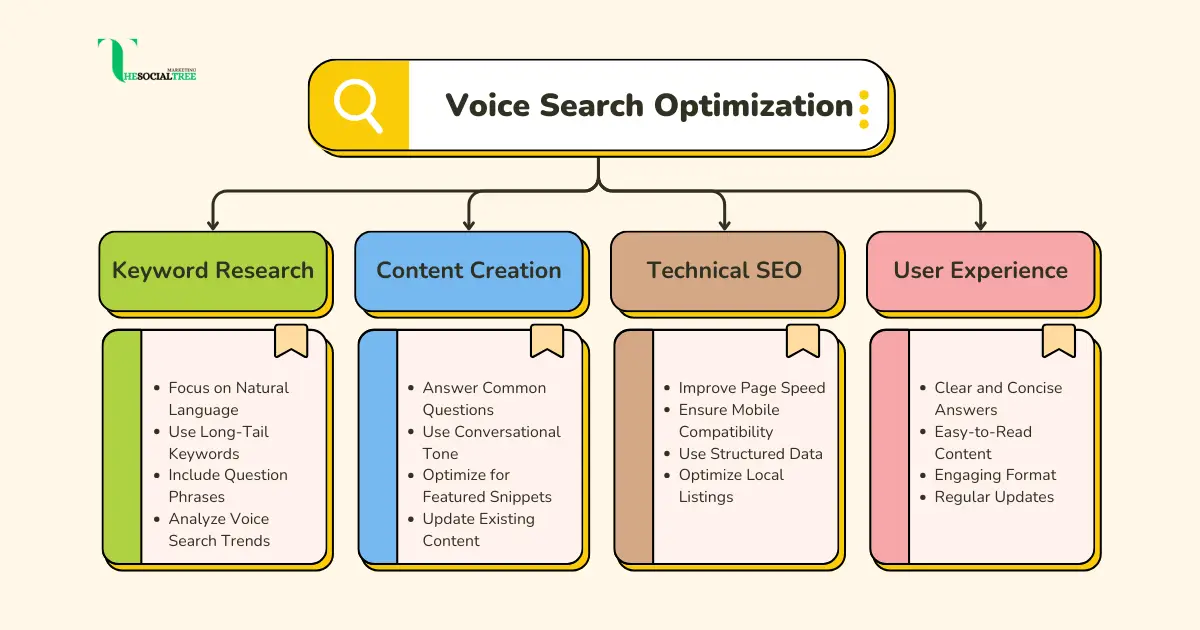Optimize Your Content for Voice Search
Optimization for voice search will become a priority by 2025 as voice search continues to grow in popularity due to the widespread use of voice assistants such as Siri, Alexa, and Google Assistant When consumers access voice commands for a more accurate, hands-free, and efficient search experience. SEO) adapt to the changing landscape here Here’s an up-to-date overview of key strategies, emerging trends, and solutions to optimize your content for voice search:

1- Focus on Natural Conversational Language
Turning to long-tail keywords: Compared to traditional typewritten queries, voice search is much more interactive and creative. People ask questions in complete sentences (e.g., “What’s the best pizza near me?” vs. “The best pizza near me”).
Solution: Add question-based, long-tail keywords to your content, including who, what, where, when, why, and how. This can help make the content more consistent with users’ natural speech patterns.
2- Use Data Structures and Schema Markup
Improved content understanding: Sound search engines rely heavily on structured data (Schema.org markup) to understand the content and provide appropriate responses.
Solution: Use schema markup to mark important elements on your pages such as concepts, questions, and product information. Markup helps voice assistants provide users with concise, accurate, and contextual information.
3- Acknowledge Thorough Local Research
Local Voice Search: Many voice searches are location-specific, such as “near me” or “best restaurant in [area]”. Voice users tend to look for near-immediate solutions.
Solution: Optimize your website for local SEO by adding location-based keywords, making sure your business information (name, address, phone number) is consistent across platforms, and making your Google My Business profile successfully
4- Mobile-first Optimization
Voice Search Mobile Dominance: A significant portion of voice search comes from mobile devices. With so many people using smartphones to query on the go, it’s important to optimize your website for mobile.
Solution: Make sure your website is mobile-friendly, with fast loading and a user-friendly experience. Google’s mobile-first ranking means that the mobile version of your site is important for ranking in both voice and traditional searches.
5- Answer Featured Snippets (voice search optimization)
Featured Snippets: Voice search often pulls direct answers from featured snippets, which are short, direct answers to questions that appear at the top of search results (position zero).
Solution: Structure your content to answer common questions directly, use bullet-numbered fonts, and include short, informative paragraphs. This increases your chances of being selected for the featured snippet.
6- Optimize Speed and User Experience (UX).
Pageload speed: Voice search users expect fast responses. Slow-loading websites can negatively affect user experience, especially on mobile.
Solution: Optimize your site for faster load times by compressing images, reducing unnecessary scripts, and implementing caching solutions. It is now an integral part of Google’s Core Web Vitals ranking.
7- Give Direct and Concise Answers
Quick Response Requirement: Voice search users expect quick and clear responses without having to navigate through pages of content.
Solution: Write content that answers user questions in 30 words or less. The more direct and detailed your response, the more likely it is that voice assistants will read it aloud.
8- Voice Search and AI-powered Personalization
Personalized Analytics: AI and machine learning personalize voice search by analyzing user preferences, behavior, and past interactions.
Solution: Create content that can meet specific user intent and interests. Provide preferences or recommendations based on location, previous searches, or trends.
9- Increase Focus on Conversational AI
Natural Language Processing (NLP): NLP is the technology behind voice search. The introduction of NLP has made it more accurate to understand the context and sensitivity of the questions used.
Solution: Keep a close eye on NLP trends to understand how search engines interpret user queries and optimize your content accordingly. Conversational outlines will contribute to better NLP responses.
10-Lots of Voice Research and Experiences
Integration of voice and visual search: In the future, users will be able to combine voice and visual search, such as asking questions while pointing to their device
Solution: Use high-quality images, text, and alt text to enhance your website’s multiple appeal. Conduct efficient visual searches along with voice searches to address this emerging trend.
11- Optimize Virtual Assistants and Smart Devices
Growing voice assistants: Virtual assistants like Alexa, Siri, and Google Assistant are becoming increasingly sophisticated, and are often used not only for simple questions but for controlling smart devices or making purchases
Solution: Create content that answers practical questions (e.g., “How to use smart home appliances”) and optimize shopping questions if you run an e-commerce business.
Why Voice Search Optimization is Important?
Optimizing voice search is mandatory because it reflects the widespread use of voice assistants like Siri, Alexa, and Google Assistant, which provide a hands-free, intuitive search experience while many people rely on voice for day-to-day tasks while ensuring identification of voice-driven questions by professionals.
Voice search tends to be conversational, location-based, and fast, making content necessary for natural language, local SEO, and quick and concise responses. Optimized voice search experience users grow, improve SEO rankings and convert. It helps businesses stay competitive in the digital environment.
Conclusion:
As voice search continues to evolve in 2025, businesses are adapting by focusing on conversational content, mobile optimization, local SEO, structured data, and faster loading experiences Voice search is increasingly about providing direct, concise, and contextual responses to content -They need a strategic shift in how they write, organize and deliver Through keeping up with trends and implementing the right solutions, businesses can improve their visibility and ensure their content is optimized for voice search.

